According to industry data, the global manufacturing industry loses more than US$2.9 trillion annually due to downtime caused by equipment failures, material delays and other issues. But in the Yangtze River Delta, a construction machinery giant’s smart factory, this number is being rewritten – by deploying RFID real-time tracking system, its production downtime sharply reduced by 50%, the overall efficiency of the equipment (OEE) to enhance the 15%, which hides behind what technology code?
Let everything ‘speak’ of industrial RFID
 RFID technology through the embedded chip electronic tags and read-write wireless communication, real-time positioning of materials, ציוד, tools and data collection. Compared with the traditional barcode need to scan one by one alignment, RFID tags can identify hundreds of goods in bulk within a range of 10 metres, and can withstand – 40 ° C אל 150 ℃ extreme environment. לדוגמה, an automobile manufacturer in each component implanted metal RFID tags, the system can be tracked in real time in the quality inspection area, three-dimensional warehouse, the flow of the sorting line status, when the assembly station triggered demand, AGV car relying on positioning data within 3 minutes of the precise distribution of materials to completely eliminate ‘people waiting for the material’ of the production line stagnation.
RFID technology through the embedded chip electronic tags and read-write wireless communication, real-time positioning of materials, ציוד, tools and data collection. Compared with the traditional barcode need to scan one by one alignment, RFID tags can identify hundreds of goods in bulk within a range of 10 metres, and can withstand – 40 ° C אל 150 ℃ extreme environment. לדוגמה, an automobile manufacturer in each component implanted metal RFID tags, the system can be tracked in real time in the quality inspection area, three-dimensional warehouse, the flow of the sorting line status, when the assembly station triggered demand, AGV car relying on positioning data within 3 minutes of the precise distribution of materials to completely eliminate ‘people waiting for the material’ of the production line stagnation.
This technological breakthrough in the field of equipment maintenance is particularly significant. Dongguan, an electrode tube enterprise for each piece of equipment paste RFID tags, record maintenance cycles, maintenance records and other information, the system automatically generates maintenance plans and early warning of potential failures, equipment downtime reduced by 30%. Wuhan heavy machine tools through the RFID chip real-time monitoring of tool wear status, tool replacement efficiency increased by 40%, machining accuracy fluctuations reduced to within 0.01 מ מ.
Closed-loop data reconstruction of production logic
The value of RFID is not only in tracking, but also in building real-time data closed loop. A chemical enterprise will RFID and WMS (Warehouse Management System), ERP deep integration, from raw materials into the warehouse to the finished product out of the whole process of data through. By analysing the warehouse turnover rate collected by RFID, the enterprise optimised 50% of the redundant safety stock and released liquidity of over ten million yuan. This data-driven decision-making in the mixed-flow production is even more powerful: SAIC-GM-Wuling in the cylinder block cylinder head production line deployment of RFID systems to support more than 6 types of mixed-flow production, the production line data collection rate increased to 99%, a single product to reduce manual operation by 5 דקות.

In predictive maintenance scenarios, the combination of RFID and IoT creates a ‘prophetic perspective’. Caterpillar deploys oil-resistant RFID sensors in key components of construction machinery, אשר, combined with big data analytics from an industrial IoT platform, predicts the probability of failure up to 14 days in advance and reduces downtime losses by more than $10 million annually. This combination of technologies can even be extended to the supply chain: a multinational electronics company to build a global RFID tracking network, raw material inventory turnover rate increased by 60%, the supply chain response speed from ‘weekly’ compressed to ‘hourly’.
From cost centre to value engine
Although the initial investment in RFID is high, the return on investment far exceeds expectations. When Protime Sports, an apparel manufacturer, introduced an RFID-enabled work order management system, employees spent 70 percent less time searching for goods, and the system paid for itself in the first year. More far-reaching value lies in the realisation of data assets: a car company used electronic identification data to accurately push maintenance services, increasing the conversion rate by 27%; through the battery health degree of financial leasing, the cost of financing was reduced by 1.2%.
Technology iteration further lowers the application threshold. Huawei’s IoT operating system LiteOS is deeply adapted to RFID readers, reducing equipment access costs by 30%; Alibaba’s cloud platform provides one-stop services from tag management to data analysis, shortening the deployment cycle for small and medium-sized enterprises to 3 חודשים. The breakthroughs of anti-metal interference tag and near-field UHF technology have increased the read rate of RFID in complex environments such as metal processing and food and pharmaceuticals from less than 20% כדי 99%.
Contact us for a demonstration of RFID tag tracking and identification






